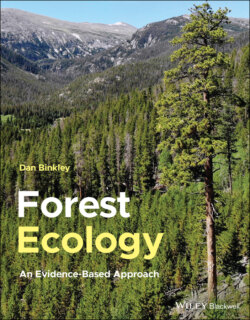Читать книгу Forest Ecology - Dan Binkley - Страница 27
Across Dozens of Generations of Trees, Almost Everything Changed at Coweeta
ОглавлениеThe past 10 000 years have seen dozens of generations of trees and forests come and go in the Coweeta Basin, in response to fluctuations in climate, events such as hurricanes, and probably sizable fluctuations in populations of humans and other animal species that influence forest dynamics. The frequency of fires may have increased as people ignited forest fires (intentionally or unintentionally). Fires may have burned the tulip poplar/mixed broadleaf stands every 200 years or so over the millennium before European settlement (Fesenmeyer and Christensen 2010). Some notable events include a near‐disappearance of eastern hemlock throughout its range, between about 5500 and 6500 years ago (Calcote 2003; Heard and Valente 2009), followed by recovery. The cause of the decline is unknown, and speculations include some sort of novel disease. This also happened to be one of the coolest times in the past 10 000 years, so multiple factors may have been involved.
Continuing back to 12 500 years ago, the continent (and much of the globe) was undergoing rapid warming as the most recent Ice Age ended. Temperatures in the Coweeta Basin would have risen by more than 5 °C from conditions that prevailed for 100 000 years. Under colder conditions, the forests in the Basin would have resembled forests that are currently found farther north, with pines and spruces dominating even the lower elevations. During some periods, the assemblages of trees species across the region included combinations that have no modern analog in local forests, or in forests now found farther north (Jackson and Williams 2004). Assemblages of tree species change in response to interactions among temperature, precipitation, and biotic factors. Unlike organisms, the genotypes of forests change routinely as species come and go.
The most notable difference in the forest at the end of the Ice Age would have been the presence of many large species of mammals in the region. The list of now‐extinct species includes tree‐browsing American mastodons; grass and tree‐browsing Columbian mammoths; woody‐plant browsing stag moose; tree‐eating giant beavers more than 2 m in length; and large predators such as dire wolves, sabretooth cats, and massive short‐faced bears. The now‐extinct mammals would have been joined by at least one now‐extinct tree species, Critchfield spruce (Jackson and Weng 1999).
